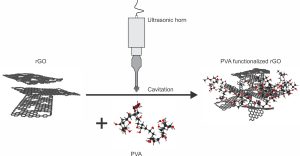Prof. Dr. Matevž Dular from the Laboratory for Water and Turbine Machines (LVTS) in collaboration with researchers from the Faculty of Chemistry and Chemical Technology (University of Ljubljana) and Argonne National Labs (USA) investigated the possibility of using ultrasonic cavitation for functionalization of reduced graphene oxide. The results of the research were published in the journal Ultrasonics Sonochemistry (IF=9,336).
Graphene, a material with exceptional thermal, electrical, optical and mechanical properties, is becoming increasingly interesting for use in modern electrical devices. By adapting its properties to a specific purpose, i.e. with its functionalization, it is possible to produce high-performance electronic systems. In the study, we achieved the functionalization of reduced graphene oxide (rGO) by sonication in a one-step process using polyvinyl alcohol (PVA) as a model molecule that binds to the rGO surface. We investigated the influence of sonication energy on the efficiency of rGO functionalization, and showed that there is an optimum, which is determined on the one hand by the minimum necessary amplitude of pressure waves, and on the other by the minimum size of rGO particles after sonication.
Link to the article: https://doi.org/10.1016/j.ultsonch.2022.106212.

Figure 1: Graphical representation of rGO functionalization by PVA using ultrasonic cavitation